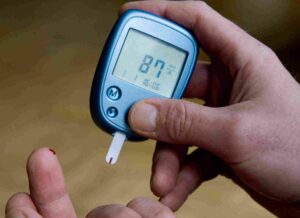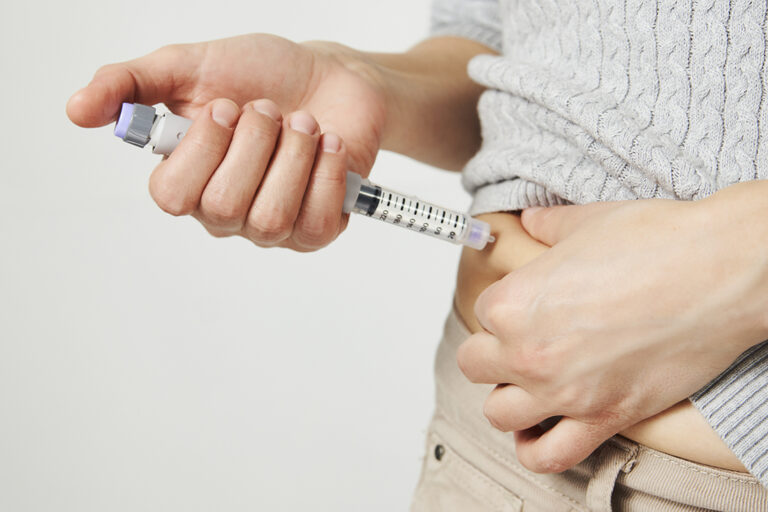Lipohypertrophy is a condition commonly faced by individuals who regularly administer subcutaneous injections, such as those with diabetes. It not only affects appearance but can also interfere with the efficacy of medication. While professional medical advice and treatment are paramount, some strategies and practices can be implemented at home to manage and potentially reduce the symptoms of lipohypertrophy. This blog aims to provide readers with an understanding of the condition and practical tips for Lipohypertrophy treatment at home.
Contents
What Is Lipohypertrophy?
 Lipohypertrophy is a medical condition characterized by an abnormal accumulation of fat under the skin. This often manifests as firm, rubbery lumps or nodules, and it commonly occurs in individuals who repeatedly inject medications, such as insulin, into the same area of the body. The frequent injections can cause the fat and tissue in the area to grow. And, leading to these noticeable and often unsightly bulges.
Lipohypertrophy is a medical condition characterized by an abnormal accumulation of fat under the skin. This often manifests as firm, rubbery lumps or nodules, and it commonly occurs in individuals who repeatedly inject medications, such as insulin, into the same area of the body. The frequent injections can cause the fat and tissue in the area to grow. And, leading to these noticeable and often unsightly bulges.
This localized increase in adipose tissue is not typically painful. However, it can be visibly distinct from the surrounding skin and may vary in size depending on the duration and frequency of injections. The development of lipohypertrophy can impact the appearance of the skin. Also has clinical implications, particularly for those managing conditions like diabetes.
The affected area may have altered blood flow and can interfere with the proper absorption of medication injected into these sites. Hence, leading to less effective treatment outcomes. The condition highlights the importance of proper injection techniques, including rotating injection sites, to minimize the risk of developing these fatty growths.
What Are Some Lipohypertrophy Treatments At Home?
Lipohypertrophy treatment at home involves a combination of preventive measures and techniques to manage and potentially reduce the size of the fatty growths. Here are some effective home-based strategies:
Rotate Injection Sites
Rotating injection sites is pivotal in both preventing and managing lipohypertrophy. Consistently injecting in the same spot leads to the overuse of that area’s subcutaneous tissue, causing lipohypertrophy. To prevent this, it is recommended to divide the potential injection area into several zones and rotate within these zones with each injection. For instance, if you’re using the abdomen for insulin injections, you might use the upper right quadrant for a week. Then switch to the upper left, followed by the lower quadrants.
Proper Injection Technique
Employing the right injection technique is crucial in managing lipohypertrophy. This involves rotating sites. And also ensuring that the injection is made into the subcutaneous fat layer and not into the muscle. It can affect absorption rates of the medication. It’s also important to use a new, sharp needle for each injection. Reusing needles can cause them to become dull, leading to more trauma in the injection site and increasing the risk of developing lipohypertrophy.
Use of Shorter Needles
The length of the needle can have a significant impact on the development of lipohypertrophy. Shorter needles, typically 4mm to 6mm, are often recommended, especially for insulin injections, as they are less likely to penetrate muscle tissue beneath the subcutaneous fat. This reduces the likelihood of repeated trauma in the same tissue area, decreasing the chance of developing lipohypertrophy.
Maintain a Healthy Lifestyle
Regular exercise and a balanced diet aid in overall fat reduction, which can also impact the subcutaneous fat layers affected by lipohypertrophy. Exercise improves circulation and can enhance the body’s ability to distribute and utilize injected medications more effectively. A diet rich in fruits, vegetables, lean proteins, and whole grains supports skin health. And can aid in maintaining a healthy weight. This is particularly important for individuals managing conditions like diabetes.
Monitor Blood Sugar Levels
 Maintaining consistent and within-range glucose levels helps in the overall management of diabetes, which in turn can have a positive impact on lipohypertrophy. Uncontrolled or fluctuating blood sugar levels can exacerbate the condition, as they might require more frequent injections or higher doses of insulin, increasing the risk of fat accumulation at injection sites. Regular monitoring, coupled with following the prescribed diabetes management plan, can assist in reducing the risk of developing lipohypertrophy.
Maintaining consistent and within-range glucose levels helps in the overall management of diabetes, which in turn can have a positive impact on lipohypertrophy. Uncontrolled or fluctuating blood sugar levels can exacerbate the condition, as they might require more frequent injections or higher doses of insulin, increasing the risk of fat accumulation at injection sites. Regular monitoring, coupled with following the prescribed diabetes management plan, can assist in reducing the risk of developing lipohypertrophy.
Avoid Tight Clothing
Wearing tight clothing, especially around the areas used for injections, can aggravate lipohypertrophy. Tight garments can apply pressure to the affected areas, potentially leading to irritation and even hindering proper circulation, which can exacerbate the condition. Opting for loose, comfortable clothing helps to minimize this risk. It is particularly important to avoid restrictive clothing immediately after administering injections, as this is when the skin and underlying tissues are most sensitive.
Skin Care
Good skin care practices play a vital role in managing lipohypertrophy. This includes keeping the skin clean to prevent infection, especially in areas used for injections. Regular use of moisturizer can maintain skin elasticity and health, which might be beneficial in managing the condition. Gentle skin exfoliation can also promote circulation and skin renewal, although it’s important to be cautious and gentle, particularly near the injection sites, to avoid causing any irritation or damage.
Regular Monitoring
Regularly monitoring the condition of the skin in areas used for injections is crucial. Individuals should frequently check for any signs of new lumps or changes in existing ones, such as size increases or changes in texture. Early detection of changes in the condition can prompt timely adjustments in injection techniques or consultation with a healthcare provider. This proactive approach is essential in managing the condition effectively and preventing further progression.
Seek Professional Advice When Necessary
While many aspects of lipohypertrophy management can be handled at home, it’s important to seek professional medical advice when necessary. If the condition worsens, becomes painful, or if there are significant changes in the injection sites, consulting a healthcare provider is crucial. Medical professionals can offer additional treatment options, adjust medication or injection protocols, and provide guidance tailored to the individual’s specific health needs.
While these lipohypertrophy treatment at home can be effective, it’s crucial to consult with a healthcare provider for personalized advice and to rule out any other underlying conditions. They can also guide any additional treatments or changes to your medication administration that may be necessary.
Can You Massage Lipohypertrophy?
 Yes, gentle massage can be beneficial in the management of lipohypertrophy. However, it must be done with caution. Massage can help by improving blood circulation to the affected area. This may aid in the breakdown and absorption of the accumulated fatty tissue. Here are some guidelines for massaging lipohypertrophy areas:
Yes, gentle massage can be beneficial in the management of lipohypertrophy. However, it must be done with caution. Massage can help by improving blood circulation to the affected area. This may aid in the breakdown and absorption of the accumulated fatty tissue. Here are some guidelines for massaging lipohypertrophy areas:
- Gentle Technique: Use a soft, gentle touch when massaging the affected area. Avoid applying excessive pressure, which could cause further damage or irritation to the tissue.
- Timing: Do not massage immediately after injecting, as this can interfere with the absorption of the medication. Wait for a suitable period, such as a few hours, before massaging the area.
- Direction of Massage: Massage in a circular motion, moving outward from the center of the affected area. This technique can help in promoting lymphatic drainage and improving circulation.
- Frequency: Regular, but not excessive, massage can be beneficial. Once or twice daily for a few minutes can be a good starting point, but this can vary depending on individual tolerance and response.
- Hygiene: Ensure that hands are clean before massaging to prevent infection, especially if the skin is broken or sensitive.
- Monitor for Changes: Pay attention to how the skin and tissue respond to massage. If there is any increase in pain, swelling, or other negative changes, stop the massages and consult with a healthcare provider.
While massage can be a helpful tool in managing lipohypertrophy, it’s important to remember that it should be part of a broader approach. Additionally, any new or worsening symptoms should be discussed with a healthcare provider.
How Long Does Lipohypertrophy Last?
The duration of lipohypertrophy can vary greatly depending on several factors, including the frequency of injections into the affected area, the individual’s overall health, and their adherence to proper injection techniques. In cases where repetitive injections are administered at the same site, this can persist or even worsen over time.
If left unaddressed, these fatty lumps may become a semi-permanent feature under the skin. However, when appropriate measures are taken, such as rotating injection sites and using proper injection techniques, the condition can improve. The time frame for improvement is not the same for everyone. In fact, in some individuals, noticeable changes might occur within a few months, while in others, it might take longer.
Conclusion
In conclusion, lipohypertrophy treatment at home, the often frustrating and unsightly condition caused by repeated injections, can be effectively handled with the right approach. By adopting simple yet crucial practices like rotating injection sites, using proper injection techniques, maintaining a healthy lifestyle, and regularly monitoring any changes in your skin, you can not only manage existing lumps but also prevent new ones from forming.
Remember, while home remedies play a vital role, consulting healthcare professionals for personalized advice is always recommended. Do you want to get rid of diabetes? Join our online diabetes treatment program and reverse Diabetes naturally through lifestyle changes such as a Personalized Diet plan, Exercise, Yoga, dieticians, and health coaches.

